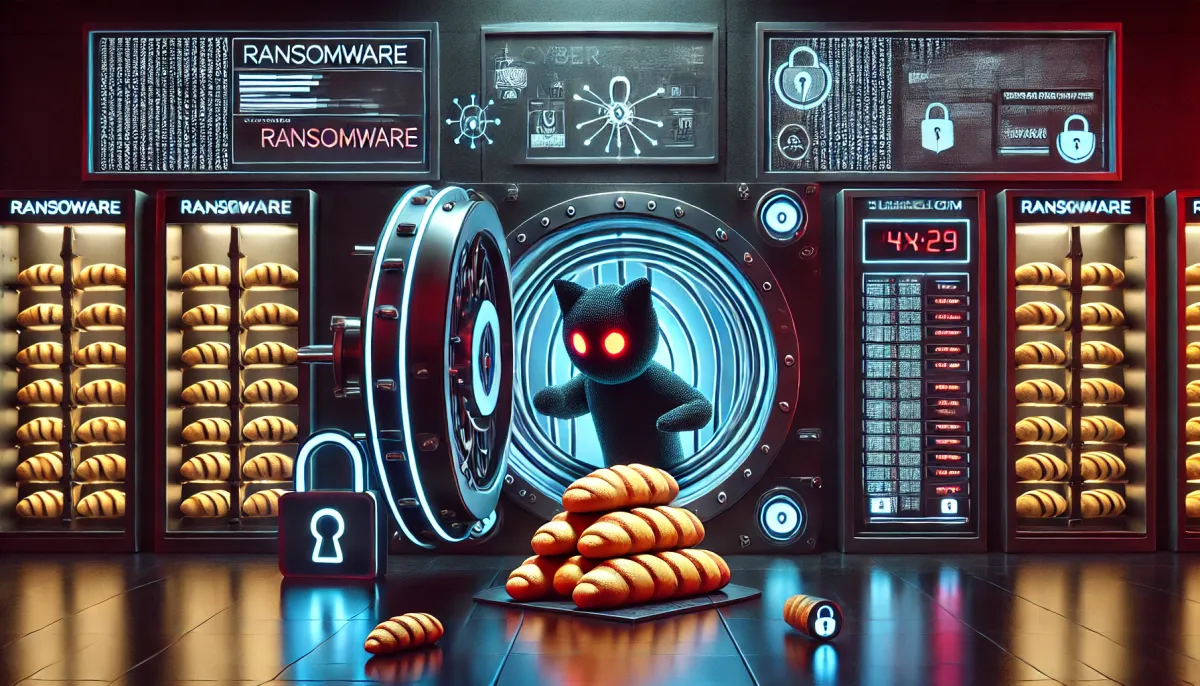Hellcat Ransomware Group: A Comparative Analysis and 2025 Target Forecast
The Hellcat ransomware group, which emerged in late 2024, has rapidly become a significant player in the global cyber threat landscape. Known for its aggressive targeting, double-extortion tactics, and unique communication style, Hellcat has already...

TL;DR
- Aggressive Targeting: Hellcat focuses on high-profile entities, including government agencies, critical infrastructure, and large corporations.
- Double-Extortion Tactics: Hellcat employs sophisticated tactics such as double-extortion, where they not only encrypt sensitive data but also exfiltrate it, threatening to release the stolen information publicly if their ransom demands are not met.
- Unique Communication Style: Hellcat is known for its unique approach to communication, often incorporating humor and cultural references into their ransom notes and public announcements.
- Advanced Methodologies: The group leverages advanced cyberattack methodologies, including exploiting niche vulnerabilities and weak credentials, to infiltrate their targets.
- Global Operations: Despite being new, Hellcat has demonstrated rapid adaptability and operates globally, with victims spanning multiple industries and regions.
- High-Profile Incidents: One notable incident involved Schneider Electric, where Hellcat demanded a ransom of $150,000 in "baguettes" and subsequently leaked 40 GB of stolen data when the ransom was not paid.
- Similar TTPs to REvil, DarkSide, and Conti: Hellcat's tactics, techniques, and procedures (TTPs) are similar to those of other notable ransomware groups like REvil, DarkSide, and Conti, particularly in their use of double-extortion tactics and targeting of high-profile entities.
Research Summary
The Hellcat ransomware group, which emerged in late 2024, has rapidly become a significant player in the global cyber threat landscape. Known for its aggressive targeting, double-extortion tactics, and unique communication style, Hellcat has already made headlines with high-profile incidents such as the Schneider Electric data breach. This report conducts a comparative analysis of Hellcat with other notable ransomware groups like REvil, DarkSide, and Conti, focusing on their tactics, techniques, and procedures (TTPs). Additionally, it provides a forecast of the sectors most likely to be targeted by Hellcat in early 2025, including the rationale behind these predictions.
Comparative Analysis of Ransomware Groups
REvil, also known as Sodinokibi, has been one of the most notorious ransomware operators, known for its double-extortion tactics where they encrypt data and exfiltrate it, threatening to release the stolen information publicly if their ransom demands are not met. REvil has targeted large organizations, demanding multimillion-dollar ransoms and often doubling the ransom if not paid within the established timeframe. They have used various entry vectors, including phishing, exploiting vulnerabilities in SonicWall appliances, and Microsoft Exchange Server CVEs. REvil's operations have been disrupted multiple times due to law enforcement actions, but they have shown resilience by re-emerging under new administrations.
DarkSide, another prominent ransomware group, is believed to be based in Russia and has shown discipline traditionally seen with nation-state actors. DarkSide is known for its sophisticated operations, including extensive reconnaissance, use of legitimate administrative tools like PsExec for ransomware deployment, and maintaining access through tools like Cobalt Strike BEACON and AnyDesk. They have targeted critical infrastructure and large corporations, demanding substantial ransoms and employing double-extortion tactics similar to REvil.
Conti, led by Russia-based threat actors, has also been a significant player in the ransomware landscape. Conti has targeted critical infrastructure and large organizations, employing double-extortion tactics and demanding high ransoms. They have used various entry vectors, including phishing and exploiting vulnerabilities in internet-facing systems. Conti's operations have been linked to the Wizard Spider group, and they have shown support for Russia's geopolitical interests, particularly during the Russia-Ukraine conflict.
Forecast for 2025
Based on the analysis of these groups, it is likely that Hellcat will continue to target high-profile entities, including government agencies, critical infrastructure, and large corporations. Their aggressive targeting and advanced methodologies suggest that they will focus on sectors with valuable data and the ability to pay substantial ransoms. The sectors most likely to be targeted by Hellcat in early 2025 include energy, healthcare, finance, and technology. These sectors are critical to national security and economic stability, making them attractive targets for ransomware groups seeking high payouts.
Assessment Rating
Rating: HIGH
The assessment rating is based on the aggressive targeting, advanced methodologies, and high-profile incidents associated with the Hellcat ransomware group. Their operations pose a significant threat to critical infrastructure, government agencies, and large corporations, making the potential impact of their attacks high.
Attribution
Historical Context
The Hellcat ransomware group emerged in late 2024 and quickly established itself as a significant player in the global cyber threat landscape. They are known for their aggressive targeting, double-extortion tactics, and unique communication style.
Timeline
- Late 2024: Emergence of the Hellcat ransomware group.
- November 2024: High-profile incident involving Schneider Electric, where Hellcat demanded a ransom of $150,000 in "baguettes" and leaked 40 GB of stolen data.
Origin
The origin of the Hellcat ransomware group is currently unknown. However, their advanced methodologies and global operations suggest a well-organized and sophisticated group.
Countries Targeted
- United States: High-profile entities, including government agencies and large corporations.
- France: Notable incident involving Schneider Electric.
- United Kingdom: Likely targets due to critical infrastructure and large corporations.
- Germany: Likely targets due to critical infrastructure and large corporations.
- Canada: Likely targets due to critical infrastructure and large corporations.
Sectors Targeted
- Energy: Critical infrastructure and high-value targets.
- Healthcare: Sensitive data and critical operations.
- Finance: High-value targets and sensitive data.
- Technology: High-value targets and sensitive data.
- Government: Critical infrastructure and high-value targets.
Motivation
The primary motivation behind the Hellcat ransomware group is financial gain. Their use of double-extortion tactics and targeting of high-profile entities suggest a focus on obtaining substantial ransoms.
Attack Types
Hellcat employs double-extortion tactics, where they encrypt sensitive data and exfiltrate it, threatening to release the stolen information publicly if their ransom demands are not met. They leverage advanced cyberattack methodologies, including exploiting niche vulnerabilities and weak credentials.
Known Aliases
No known aliases for the Hellcat ransomware group have been identified at this time.
Links to Other APT Groups
No known links to other APT groups have been identified at this time.
Similar Threat Actor Groups
- REvil: Similar double-extortion tactics and targeting of high-profile entities.
- DarkSide: Similar advanced methodologies and targeting of critical infrastructure.
- Conti: Similar double-extortion tactics and targeting of high-profile entities.
Counter Strategies
-
Implement Multi-Factor Authentication (MFA): Use MFA to protect against unauthorized access to critical systems and data.
- Actionable Takeaways: Ensure MFA is implemented for all remote access points and critical systems.
-
Regularly Update and Patch Systems: Keep systems and software up to date with the latest security patches to prevent exploitation of known vulnerabilities.
- Actionable Takeaways: Implement a robust patch management process to ensure timely updates and patches.
-
Conduct Regular Security Audits and Penetration Testing: Regularly assess the security posture of your organization through audits and penetration testing.
- Actionable Takeaways: Identify and remediate security weaknesses before they can be exploited by threat actors.
Known Victims
- Schneider Electric: High-profile incident where Hellcat demanded a ransom of $150,000 in "baguettes" and leaked 40 GB of stolen data.
- Actionable Takeaways: Implement robust incident response and data protection measures to mitigate the impact of ransomware attacks.
Recommendations, Actions, Suggested Pivots, Forecasts and Next Steps..
(Subscribers Only)


![[DEEP RESEARCH] Zero-Days Are a Distraction: 2025’s Biggest Losses Were Stolen Tokens + OAuth](/content/images/size/w600/2025/12/zz-3.png)


